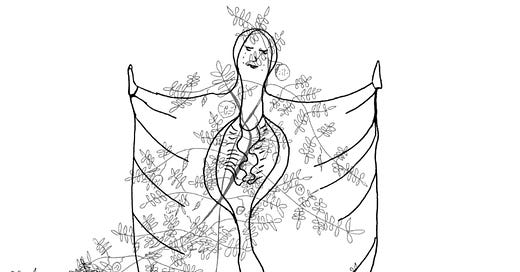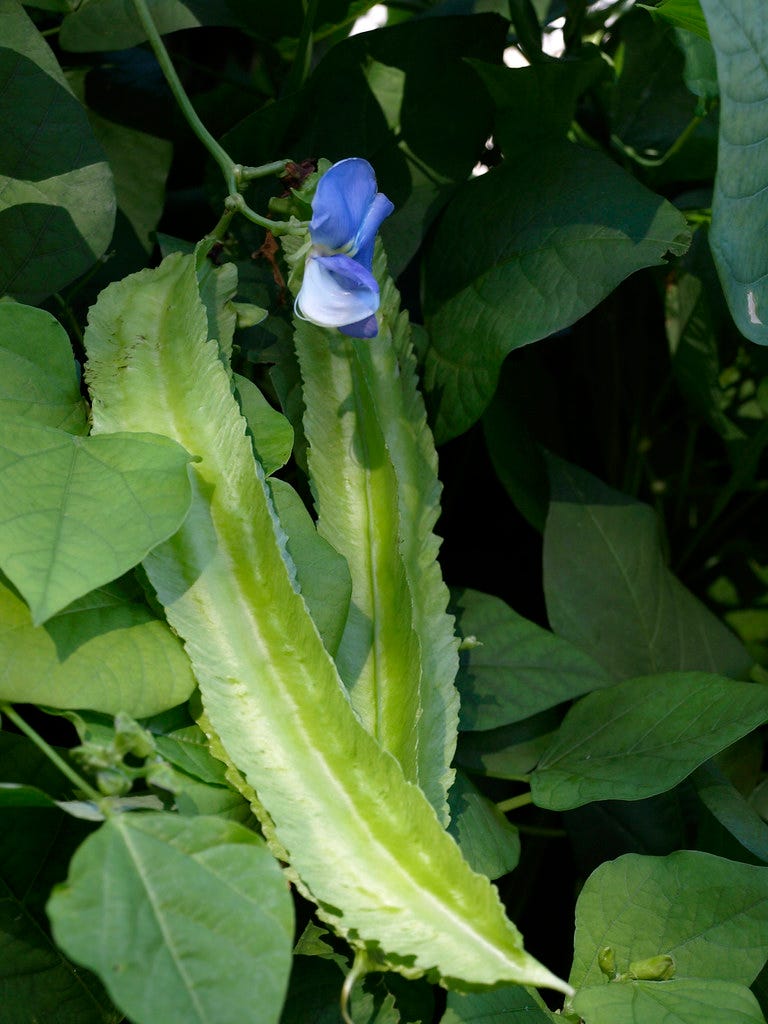ALSO KNOWN AS: Clitoria ternatea, bluebell vine, Darwin pea, Cordovan pea, Aparjit (Hindi), Asian pigeonwings, Shankhpushpi, Fula Criqua (Portuguese meaning “flower of creation), Pukingan (Tagalog), Bunga Telang (Malay), mussel shell creeper, Kakkattan (Tamil), Aparajita (Bengali), conch flower
how to know
pinnate leaves, so green they glow
blue flowers that look like doves flying or vulvas
woody bases by the soil
crawling or climbing
bean pods that fade to yellow when dried and have six to ten seeds
The first time I drank a tisane from the butterfly pea I was in the Pacific Northwest visiting family. We were in a hot tub at a local hot spring. The air was fraying with smoke. Barely contained fires were all around us, and I was beginning to cough. But we had saved up for this. Despite working for this all year, our eyes now teared from the particles. As if we were dismal kings, we were brought tea on a tray. The teacups was metal. I only knew the tea was blue when I reached my fingers into the dark cup and brought forth a fairy tale blue that dripped to the floor as soon as it came out. Nothing made sense.
To some the butterfly pea is a goddess who is unconquerable.
Beans that Take Space
Used to growing where the forest floor is opened and light shines through, the butterfly pea grows in patches of sun. It is a creeper, used to crawling along the ground with a bright green, the kind of bean green that looks like it’s illuminated from within. But given a trellis or a tree it can climb. The oval leaves are compound pinnate, meaning a handful of leaflets emerge from a single stem. And the stems along the branches are opposite one another with soft hairs sensing the world. The base of the stems, where the plant dives into the soil, are woody. The plant can extend up to 15 feet wherever it goes. While this plant prefers moist, well-draining, neutral soil and afternoons of cascading sun, it can grow - though unhappily - in drought conditions or clay soils. It can also survive some cooler, nearly freezing temperatures. Everything is delicate about the appearance of the butterfly pea, but it is infinitely valued for its adaptability.
Given some soil and time, when the germinated, or the cuttings are settled in the soil, the butterfly pea will grow joyfully. It grows alone. It grows over bare earth.
You wouldn’t know the flowers are made up of five petals because they look like a clitoris and a vulva, but they also look like pigeon wings in motion, radiating from the center is ray-like venation, a soft white glows from the center. There is a prominent oval, as if a pigeon is swooping to land, the top of which two winglike petals emerge, like the closed wings of a dove. They are a humble step for a bee called the keel. Within these two white petals are two more that are so small they can’t be seen. These petals are always white and they hold very small reproductive organ which is made up of cream male anthers and a female pistil. It can be pollinated by bees, moths, butterflies, or the gentle bodies of wind that pass through the petals or it can be self pollinated.
The flowers are blue, a deep and true blue. Yes, they can sometimes be pink or even white. But you can bet you’ll see it blue. Perhaps their color is so very strong, so potent a visual for insects who feed on it, because it blooms for a single day, then withers with the setting sun. As a tisane it tastes slightly woody, and sweet. I wonder what the bees taste, or how they sense the intoxicating color as they work to unfold the flower - work to receive its nectar.
As part of the Fabacae, or legume, family, the butterfly pea has bean pods that, unless harvested, will slowly dry until they twist and pop open. Like many of these beans, the butterfly pea also has a penchant for community building. Sure, the plant could be aggressive in certain ecosystems. Though sometimes butterfly pea is intentionally introduced to cover earth that has been cleared. Here it activates the soil by fixing the nitrogen, making it welcoming for other plants. In this way, with management, it becomes a salve for soil. A nitrogen fixing plant extends its shoots into the ground to search for soil dwelling bacteria. This bacteria will then provide the plant with gaseous nitrogen from the air and in return the butterfly pea plant will feed the bacteria carbohydrates. Thus the butterfly pea plant can fix nitrogen into the soil, making it a beautiful cover crop. On the field it can also be used with livestock. The butterfly pea is prime grazing fodder. Livestock love it above any other bean or hay. In addition to food for goats, cows, and sheep, it can be used as an herbal veterinary medicine for a variety of animals including dogs and mice, for rats.
A Floral Mood Ring
Lately butterfly pea has been popular as a spa water, a spa tea, a wellness trend. Despite its tropical origins, as a tisane it is the aquamarine from the interior of glaciers. The color is so vibrant it looks synthetic. Its cultural significance far outlives the facile wellness accoutrement.
A plant with many names is beloved in many different cultures, and the butterfly pea has a name throughout the world. Humans have fallen in love with the butterfly pea for its beauty and usefulness, but we see mirrors wherever we go. This is not an incitement on us, we are storytellers: always looking for patterns. This plant has been named for the female genitalia, but before that, it was honored as a female deity because its flower looks exactly like a clitoris and vulva. This is no surprise, flowers have a tendency to look like genitalia. If you haven’t seen this, I invite you to take a good hard look at an orchid. Regardless, the image of the flower might have lent to the mythic understanding of this plant.
In all, there are 35 species of butterfly pea native to warm climates all over the world. This particular brilliant blue variety was first folded into western science in Indonesia in the 1600’s by the Polish-German Johann Philipp Breyne who recognized the clitoral shape of a species already identified by the great ‘namer’ of life, Carl Linneaus, and categorized it, Clitoria ternatea based on the Linneas naming system. Though it has names far beyond this, because its native range spans the Indian Ocean from Africa, to India, and Indonesia and the Philippines, the exact location is unclear. Ternate is the main island in North Muluka in the Muluka sea, where the plant specimen that Breyne named was from. Now this plant has been introduced throughout the tropics of the world.
Aparajita is a complicated name with Sanskrit in origin and is the Bengali and Hindi name for this plant. The word means “the unconquerable”. Depending on the location and manifestation it is also the name of a male or female deity. In India, in particular, Aparajita shares the name of a manifestation of the deity Druga in the Hindu religion. She is an aspect of the divine goddess and is worshipped throughout the year, but her manifestation of Aparajita’s sacred day is celebrated on a September day, the seventh day of the bright fortnight of Bhādra, which is the Hindu calendar of the year.
Aparajita crowns herself with a crescent moon; has snakes around her wrists, and rides a lion. Around her neck can lie a wreath of oval blue flowers which are her namesake. She is unconquerable - you can’t attack a cloud.
If the butterfly pea was to speak it would speak in color. The colors can drastically change depending on acid or alkaline addition. Not only is this significant ethnobotanically, synthetic blue dyes are very often not biodegradable and can be cancerous if used regularly. The main color changing ability is made possible by the anthocyanins in the flower. Add an acidic lemon and a butterfly pea tea will turn violet, or pink because the red flavylium is triggered. With an alkaline substance with black beans or almonds, chalcone yellow will come through, creating a green. Without additives, the color remains that ice cold blue of the flower at a PH of 3.2-5. So the butterfly pea is traditionally used as a dye and food colorant. The leaves can also be used to produce a green dye.
The medicinal value of the butterfly pea has sustained for thousands of years, notably in Ayurvedic tradition. It has been revered for its memory and learning, anti-stress, antidepressant, and sedative properties. The bark and peas, and roots are used as a diuretic. Though if prepared properly, the peas can be eaten like green beans. Its blue has been used in the traditional Malaysian Nyonya dish, among many other dishes throughout Malaysia, Indonesia, and the Philippines. Studies are being done on this, and have been proven for rats. In Cuba the macerated roots are used to induce labor or for other menstrual ailments, as an emmenagogue, because it can stimulate blood flow in the pelvic area. In addition to its anthocyanins that make it an antibacterial and anti-cancer agent it can be used to treat diabetes, and it has cyclotides, which allow it to be an insecticide. In a garden, they rarely have pests, standing in pristine blue and green. They are high in vitamins A, C, and E.
In the face of destruction, life is ever more present, unwilling to be ignored. The butterfly pea invites the idea that the unconquerable is infinitely soft. You can’t fight a cloud just as much as you can’t bomb a dream. Whether it was because this plant could heal the sick, or ready the soil for planting, or just growing and growing and growing or inspiring lurid imaginings, or simply changing. The butterfly pea plant has been seen as the deity which can’t be conquered. This is wisdom we can draw from, how can we embody that which is both brilliant as a glacier and soft as an ocean: ten thousand drops of blue.
myth for butterfly pea
Not to be confused with winged bean. These beans are wild. The pods look like boondoggles. While the flowers are blue but much smaller. The two central petals extend down, while the single rounded petal remains a half circle above the flower.
Or morning glory. Yes, they both climb, their both the most precious green. Their flowers are trumpets and their heart shaped leaves.
Forager Friendly?
Yes, harvest with care.
Sources:
https://www.britannica.com/place/Indonesia
https://plants.ces.ncsu.edu/plants/clitoria-ternatea/
https://tilthalliance.org/resources/how-legumes-fix-nitrogen-in-your-soil/
https://pmc.ncbi.nlm.nih.gov/articles/PMC6546959/
https://www.missouribotanicalgarden.org/PlantFinder/PlantFinderDetails.aspx?taxonid=280445
https://pfaf.org/user/Plant.aspx?LatinName=Clitoria+ternatea
https://permacultureplants.com/plants/butterfly-pea/
https://www.inaturalist.org/taxa/160759-Clitoria-ternatea
https://www.nparks.gov.sg/florafaunaweb/flora/1/3/1372
https://www.hinduamerican.org/blog/hindu-puja-instructions
https://www.sciencedirect.com/science/article/abs/pii/S0378874108004911
https://edis.ifas.ufl.edu/publication/EP573
https://pmc.ncbi.nlm.nih.gov/articles/PMC8718764/
https://www.nlb.gov.sg/main/article-detail?cmsuuid=c0b030f8-63ea-4144-b4c6-134193a5c57b
https://mega-onemega.com/the-nutritional-benefits-of-eating-butterfly-pea-flowers/
https://www.efsa.europa.eu/en/supporting/pub/en-7084
https://www.cabidigitallibrary.org/doi/full/10.1079/cabicompendium.55416
https://en.wikipedia.org/wiki/Cyclotide
https://www.youtube.com/watch?v=42qKv5VlGRY
https://www.wisdomlib.org/definition/aparajita
https://www.hindupedia.com/en/Aparājitā
https://www.youtube.com/watch?v=39lDm7fA4ZI







